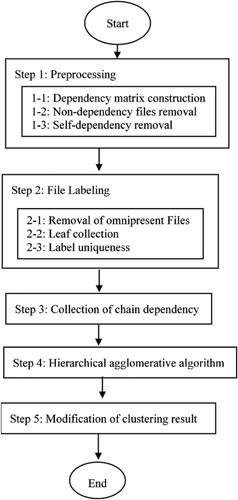当前位置:
X-MOL 学术
›
IET Softw.
›
论文详情
Our official English website, www.x-mol.net, welcomes your feedback! (Note: you will need to create a separate account there.)
Using multi-pattern clustering methods to improve software maintenance quality
IET Software ( IF 1.6 ) Pub Date : 2022-11-03 , DOI: 10.1049/sfw2.12075 Yi-Ting Chen, Chin-Yu Huang, Tsung-Han Yang
IET Software ( IF 1.6 ) Pub Date : 2022-11-03 , DOI: 10.1049/sfw2.12075 Yi-Ting Chen, Chin-Yu Huang, Tsung-Han Yang

|
In software engineering, a software development process, also known as software development life cycle (SDLC), involves several distinct activities for developing, testing, maintaining, and evolving a software system. Within the stages of SDLC, software maintenance occupies most of the total cost of the software life. However, after extended maintenance activities, software quality always degrades due to increasing size and complexity. To solve this problem, software modularisation using clustering is an intuitive way to modularise and classify code into small pieces. , A multi-pattern clustering (MPC) algorithm for software modularisation is proposed in this study. The proposed MPC algorithm can be divided into five different steps: (1) preprocessing, (2) file labelling, (3) collection of chain dependencies, (4) hierarchical agglomerative clustering, (5) modification of the clustering result. The performance of the proposed MPC algorithm to selected clustering techniques is compared by using three open-source and one closed-source software programs. Experimental results show that the modularisation quality of the proposed MPC algorithm is nearly 1.6 times better than that of the expert decomposition. Additionally, compared to other software clustering algorithms, the proposed MPC algorithm, on average, has a 13% enhancement in producing results similar to human thinking. Consequently, it can be seen that the proposed MPC algorithm is suitable for human comprehension while producing better module quality compared to other clustering algorithms.
中文翻译:

使用多模式聚类方法提高软件维护质量
在软件工程中,软件开发过程,也称为软件开发生命周期 (SDLC),涉及开发、测试、维护和发展软件系统的几个不同活动。在SDLC的各个阶段,软件维护占据了软件生命周期总成本的大部分。然而,在延长维护活动之后,软件质量总是会由于规模和复杂性的增加而下降。为了解决这个问题,使用集群的软件模块化是一种将代码模块化和分类为小块的直观方法。,本研究提出了一种用于软件模块化的多模式聚类(MPC)算法。所提出的 MPC 算法可以分为五个不同的步骤:(1) 预处理,(2) 文件标记,(3) 链依赖项的收集,(4)层次凝聚聚类,(5)聚类结果修正。通过使用三个开源软件程序和一个闭源软件程序,比较了所提出的 MPC 算法对选定聚类技术的性能。实验结果表明,所提出的 MPC 算法的模块化质量比专家分解的模块化质量高近 1.6 倍。此外,与其他软件聚类算法相比,所提出的 MPC 算法在产生类似于人类思维的结果方面平均提高了 13%。因此,可以看出,与其他聚类算法相比,所提出的 MPC 算法适合人类理解,同时产生更好的模块质量。通过使用三个开源软件程序和一个闭源软件程序,比较了所提出的 MPC 算法对选定聚类技术的性能。实验结果表明,所提出的 MPC 算法的模块化质量比专家分解的模块化质量高近 1.6 倍。此外,与其他软件聚类算法相比,所提出的 MPC 算法在产生类似于人类思维的结果方面平均提高了 13%。因此,可以看出,与其他聚类算法相比,所提出的 MPC 算法适合人类理解,同时产生更好的模块质量。通过使用三个开源软件程序和一个闭源软件程序,比较了所提出的 MPC 算法对选定聚类技术的性能。实验结果表明,所提出的 MPC 算法的模块化质量比专家分解的模块化质量高近 1.6 倍。此外,与其他软件聚类算法相比,所提出的 MPC 算法在产生类似于人类思维的结果方面平均提高了 13%。因此,可以看出,与其他聚类算法相比,所提出的 MPC 算法适合人类理解,同时产生更好的模块质量。实验结果表明,所提出的 MPC 算法的模块化质量比专家分解的模块化质量高近 1.6 倍。此外,与其他软件聚类算法相比,所提出的 MPC 算法在产生类似于人类思维的结果方面平均提高了 13%。因此,可以看出,与其他聚类算法相比,所提出的 MPC 算法适合人类理解,同时产生更好的模块质量。实验结果表明,所提出的 MPC 算法的模块化质量比专家分解的模块化质量高近 1.6 倍。此外,与其他软件聚类算法相比,所提出的 MPC 算法在产生类似于人类思维的结果方面平均提高了 13%。因此,可以看出,与其他聚类算法相比,所提出的 MPC 算法适合人类理解,同时产生更好的模块质量。
更新日期:2022-11-03
中文翻译:

使用多模式聚类方法提高软件维护质量
在软件工程中,软件开发过程,也称为软件开发生命周期 (SDLC),涉及开发、测试、维护和发展软件系统的几个不同活动。在SDLC的各个阶段,软件维护占据了软件生命周期总成本的大部分。然而,在延长维护活动之后,软件质量总是会由于规模和复杂性的增加而下降。为了解决这个问题,使用集群的软件模块化是一种将代码模块化和分类为小块的直观方法。,本研究提出了一种用于软件模块化的多模式聚类(MPC)算法。所提出的 MPC 算法可以分为五个不同的步骤:(1) 预处理,(2) 文件标记,(3) 链依赖项的收集,(4)层次凝聚聚类,(5)聚类结果修正。通过使用三个开源软件程序和一个闭源软件程序,比较了所提出的 MPC 算法对选定聚类技术的性能。实验结果表明,所提出的 MPC 算法的模块化质量比专家分解的模块化质量高近 1.6 倍。此外,与其他软件聚类算法相比,所提出的 MPC 算法在产生类似于人类思维的结果方面平均提高了 13%。因此,可以看出,与其他聚类算法相比,所提出的 MPC 算法适合人类理解,同时产生更好的模块质量。通过使用三个开源软件程序和一个闭源软件程序,比较了所提出的 MPC 算法对选定聚类技术的性能。实验结果表明,所提出的 MPC 算法的模块化质量比专家分解的模块化质量高近 1.6 倍。此外,与其他软件聚类算法相比,所提出的 MPC 算法在产生类似于人类思维的结果方面平均提高了 13%。因此,可以看出,与其他聚类算法相比,所提出的 MPC 算法适合人类理解,同时产生更好的模块质量。通过使用三个开源软件程序和一个闭源软件程序,比较了所提出的 MPC 算法对选定聚类技术的性能。实验结果表明,所提出的 MPC 算法的模块化质量比专家分解的模块化质量高近 1.6 倍。此外,与其他软件聚类算法相比,所提出的 MPC 算法在产生类似于人类思维的结果方面平均提高了 13%。因此,可以看出,与其他聚类算法相比,所提出的 MPC 算法适合人类理解,同时产生更好的模块质量。实验结果表明,所提出的 MPC 算法的模块化质量比专家分解的模块化质量高近 1.6 倍。此外,与其他软件聚类算法相比,所提出的 MPC 算法在产生类似于人类思维的结果方面平均提高了 13%。因此,可以看出,与其他聚类算法相比,所提出的 MPC 算法适合人类理解,同时产生更好的模块质量。实验结果表明,所提出的 MPC 算法的模块化质量比专家分解的模块化质量高近 1.6 倍。此外,与其他软件聚类算法相比,所提出的 MPC 算法在产生类似于人类思维的结果方面平均提高了 13%。因此,可以看出,与其他聚类算法相比,所提出的 MPC 算法适合人类理解,同时产生更好的模块质量。



























 京公网安备 11010802027423号
京公网安备 11010802027423号